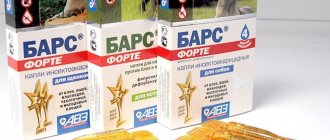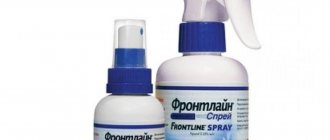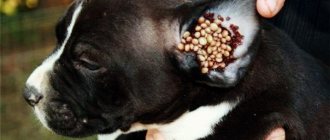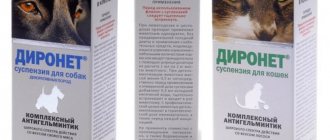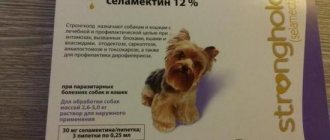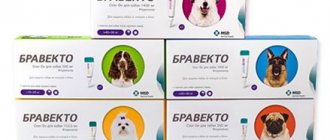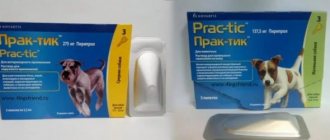| Description of the drug | |
| Release form and storage conditions: | Brown round tablets with 5 dosage options; store out of the reach of children and dogs at a temperature of 0-30°C |
| Price: | 1200-1700 rubles per tablet |
| Analogues: | Frontline |
Pharmacological properties
Bravecto is an insectoacaricidal drug with systemic action. The fluralaner included in the drug is (4-[5-(3,5-dichlorophenyl)-5-(trifluoromethyl)-4H-isoxazol-3-yl]-2-methyl-N-[2-oxo-2-(2 ,2,2-trifluoroethylamino) ethyl] benzamide) is an insectoacaricide of the isoxazoline group, active against fleas (Ctenocephalides felis and Ctenocephalides canis) and ixodid ticks (adults and larvae of Ixodes ricinus, Ixodes hexagonus, Ixodes scapularis, Ixodes holocyclus, Dermacentor retic ulatus, Dermacentor variabilis and Rhipicephalus sanguineus), parasitic on dogs. The mechanism of action of fluralaner is to block GABA-dependent and glutamate-dependent receptors of arthropods, hyperexcitation of neurons, disruption of the transmission of nerve impulses, which leads to paralysis and death of ectoparasites. After oral administration of the drug, fluralaner is easily absorbed from the gastrointestinal tract and reaches the systemic bloodstream, the maximum concentration in the blood plasma is achieved within 1 day, bioavailability is 20-27%, food intake accelerates absorption. Fluralaner is excreted slowly, mainly in unchanged form with feces (~90% of the dose) and partially with urine, the half-life is 12 days. The drug begins to act 4 hours after application and causes the death of fleas 8 hours after attachment to the host’s body, ticks - after 12 hours, preventing re-infestation of dogs with ectoparasites. The death of fleas occurs before laying eggs, which prevents contamination of premises with eggs and larvae. In terms of the degree of impact on the body, Bravecto is classified as a “low-hazard” substance (hazard class 4 according to GOST 12.1.007-76); in recommended doses it does not have embryotoxic, teratogenic, or mutagenic effects.
What is the drug intended for?
The instructions contain the following indications for the use of Bravecto tablets for dogs:
- destruction of ectoparasites and prevention of their appearance;
- in complex therapy of dermatitis of allergic origin;
- acariasis caused by ixodid ticks.
Bravecto has been successfully used in the treatment of demodicosis, otodectosis and sarcoptic mange. The drug also prevents infection with babesiosis, caused by infected ticks of the genus Dermacentor reticulatos.
Doses and method of administration
Bravecto is administered to dogs individually orally during or shortly before/after feeding at a therapeutic dose of 25-56 mg fluralaner per 1 kg of animal weight. The drug has an attractive aroma and taste and, as a rule, is readily eaten by dogs; otherwise, the drug is forcibly administered directly into the mouth or fed with food. Breaking tablets is not allowed.
You should make sure that the dog has completely swallowed the required dose of the drug.
Doses of the drug:
| Dog weight, kg | Dose of active substance (mg/tablet) and number of tablets |
| 2 — 4,5 | 1 tablet - 112.50 mg |
| 4,5 — 10 | 1 tablet - 250 mg |
| 10 -20 | 1 tablet - 500 mg |
| 20 — 40 | 1 tablet - 1,000 mg |
| 40 -56 | 1 tablet - 1,400 mg |
| > 56 | A combination of two tablets is selected at the rate of 25-56 mg fluralaner per 1 kg of animal weight |
The drug can be used during pregnancy and lactation. Repeated treatments, if necessary, are carried out after 12 weeks.
Bravecto: harm or benefit?
You probably don’t know yet that in the European Union they are collecting votes and signing a petition that will ban the production and sale of the anti-tick drug Bravecto.
Why did this happen? More than 5,000 cases of disease have already been officially registered, of which about 300 are fatal!
At the moment, the following alarming facts are known about the drug:
— There is not a single actual antidote that can quickly relieve intoxication or the development of anaphylactic shock.
— In Europe, the drug has been known for a long time, but the license certificate was received relatively recently (they refused to register it for a very long time) and most veterinarians opposed this drug, after which it rushed onto the Russian market.
— Initially, the English-language instructions did not mention ixodid ticks, and only after a short study the annotation was changed.
— Before entering our market, the drug was studied for only 112 days.
— Many owners report vomiting after using it, blood and mucus in the urine. There are already reports of several cases of severe disease, especially among puppies and mini breeds. The data is available on the K-9 forum.
— “Bravecto” is a centrally acting drug and, unlike drops on the withers, does not accumulate in the subcutaneous tissues, but circulates throughout the bloodstream, reaching all organs and tissues. It does not repel ticks, but acts after a bite by binding to blood plasma protein. Part of the drug breaks down into metabolites that are excreted in feces and urine.
— There is no reliable data on long-term side effects. The drug was tested in Canada, and in an area where ixodid ticks are practically not found.
— The effectiveness of Bravekta was reliably confirmed only for ONE month, and not 3 as stated, these data were confirmed, among other things, by the drug development team, taking into account the characteristics of our climate, the state of forests and the procedure for treating hazardous areas. Simply put, in our Palestines, manufacturers are ready to confirm safety only within one month! Moreover, now even doctors themselves recommend combining this drug with drops and collars.
— The drug is an insectoacaricide and has neither contact nor repellent properties. For it to start working, the tick must dig in, unlike drops based on propaxur and permethrin, which reduce the activity of the crawling tick and prevent it from digging in. Moreover, in addition to Babesia, ticks carry the risk of contracting Lyme disease (borreliosis) and the more ticks there are, the higher the risk of contracting this disease. The action of Bravekta begins 18 hours after the bite.
— The packaging of this drug entering the Russian Federation indicates the registration certificate of Kazakhstan! On the packaging and in the instructions it is written that Vienna. Austria. But only the Russian division of the company is called Intervet LLC, being part of MSD Animal Health. (Intervet LLC Address: Moscow region, Naro-Fominsk district) So what happens, “Bravecto” was made in the Naro-Fominsk region? If this is so, then how can this explain the Kazakh registration and claims in Belarus?
Combined with the limited time and number of animal tests in our region, taking into account the inconsistencies in certification, the information on this drug is more than alarming. Thus, the drug “Bravecto” does not have Russian certification and was only declared for the right to sell in the Russian Federation, which is why the RosStandart badge is on the packaging. Manufacturers explain this as purely paperwork, but it took them several years to obtain certification in the European Union, and there were a lot of objections about the advisability of issuing them a certificate.
Pharmacodynamics of the drug "Bravecto"
1. The effectiveness of the drug depends on the degree of its binding to plasma proteins. The less the drug binds, the greater its effect.
2. Drugs are found in the blood in two forms: bound and unbound.
3. It is the unbound portion of the drug that will have a therapeutic effect. Also, this part can be subjected to biotransformation and/or elimination. For example, the “bound portion” of the anticoagulant warfarin is 97%. This means that of all warfarin administered into the body, 97% is bound to blood proteins. The remaining 3% (unbound part) of the drug is active and can be excreted. Protein binding may affect the half-life of drugs. The bound portion acts as a reservoir or depot from which the drug is slowly released as a free form. While the unbound portion is metabolized and/or excreted from the body, the bound portion will be released to maintain equilibrium.
4. Only unbound fractions of the drug are metabolized in the liver and other organs. The more the drug goes into free form, the more it is metabolized. Those. The linked part is not active. The release rate depends on the chemical formula, in this case for a critical drop in concentration - 12 weeks. The released substance is harmful to ticks and babesias. Once release occurs, it is excreted unchanged from the body. The continuity of the process ensures the desired effect. After studying the information on Bravecto, I decided for myself that I would not use it. Many questions arise to which there are no answers. The drug has no toxicology data and no pharmacokinetics.
I find the studies (after euthanasia of the subjects) of this drug incomplete and unreliable (the results given are convenient to the manufacturer). For example, upon autopsy 160 days after use, the liver was not tested for the substance (or was not tested at all). After the autopsy, the weight of the organs of dogs that received Bravecto and those that did not was compared, that’s all that was studied in this regard (ridiculous considering that the weight of the substance in the tablet is 250-500 mg).
The conclusion that only 90% of the substance is excreted from the body (through the liver and kidneys) is just the manufacturer’s assumption. The calculations were made using a generalized formula from an outside source and are listed in the studies as “assumed.”
Bravecto has been on the market in Europe for several years, I found correspondence between users and a representative of the manufacturer. It must be said that all the answers are very streamlined, no specific data, just words.
Fluralaner (active ingredient) belongs to the isoxazoline group of drugs. This group includes many pesticides and herbicides, as well as insectoacaricidal preparations. Moreover, I read in one paper that this group of drugs has not yet been sufficiently studied. I came across several dissertations on the synthesis of new drugs of this group. They have synthesized a bunch of them, but their properties have not yet been tested and are not known, they are only assumed. Thus, this is still a very raw and little studied product.
When using it, there have already been cases of serious illnesses in dogs, even death!
special instructions
Violations of the drug use regimen should be avoided, as this may lead to a decrease in its effectiveness. If the next treatment is missed, the use of the drug is resumed at the same dose according to the same regimen.
With the simultaneous use of Bravecto with anthelmintics, antibiotics, non-steroidal anti-inflammatory drugs and glucocorticosteroids, no adverse reactions or reduction in the effectiveness of the drug were detected.
Bravecto is not intended for use in food producing animals.
Release forms
The insectoacaricide is available in tablet and liquid form (solution). Each release form is produced in 5 dosages.
| Animal parameters | Chewable tablets (mg) | Drops (mg) |
| Decorative (2-4.5 kg) | 112,5 | 112,5 |
| Small (4.6-10 kg) | 250 | 250 |
| Medium (10-20 kg) | 500 | 500 |
| Large (21-40 kg) | 1000 | 1000 |
| Very large (41-56 kg) | 1400 | 1400 |
Bravecto chewable pill with meat flavor is intended for internal use. It has a round shape and color from light to dark brown. Each unit of the medicine is packaged in a sealed blister package.
The package contains 1 pill, which is given to the dog once, not divided into several doses.
The liquid form of the drug is a clear solution that may have a clear or yellowish color. Available in pipettes packaged in laminated sachets.
How to get a dog to eat a pill
If the dog refuses to eat the pill, the drug is given forcibly. An experienced veterinarian will help you cope with this task.
When it is not possible to visit a veterinary clinic and the animal is not aggressive, you can try feeding the drug to the animal yourself.
It is less problematic to give medicine to small dogs. It is enough to secure the pet between your legs or swaddle it in a blanket, placing it on your lap. If the animal is large, you may need the help of a second person.
Before giving the dog a Bravecto tablet, tilt the pet's head slightly back. After this, they clasp the muzzle with one hand, squeezing the jaws at the base. As soon as the dog opens its mouth, the tablet is placed on the root of the tongue. A special peeler, which is sold in veterinary pharmacies, will help to facilitate this process.
After the pill is on the root of the tongue, the animal’s mouth is squeezed with one hand, and the throat is stroked with the other so that the pet makes a swallowing movement.
A more loyal way of giving is to wrap the tablet in the dog’s favorite treat. It could be cheese or a piece of meat.
How to determine a dog's weight
Before taking Bravecto, small dogs can be weighed at home using a steelyard by placing the dog in a bag or sack. If the pet is small or medium in size and there are floor scales in the house, then proceed according to the following scheme:
- First, weigh yourself.
- Then the animal is picked up and placed on the scale.
- The second is subtracted from the first indicator.
The resulting difference in weight will be the body weight of the animal.
It is problematic to weigh large animals in this way. You can contact the nearest large store or warehouse and ask to weigh the animal on a vag.
If none of the presented options is suitable, then you can try to approximately determine the dog’s weight using a tape measure or tailor’s yardstick.
To do this, use a tape to measure the circumference of the chest behind the shoulder blades and the oblique length of the body (the distance from the shoulder joint to the croup). By correlating the girth of the chest and the oblique of the body, you can calculate the approximate weight of the animal using the table below.
